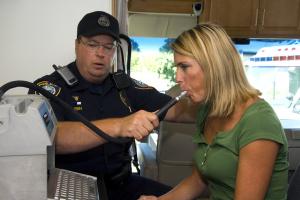
I'm sure we all have heard stories about the dangers of drinking and driving, and some of us may have witnessed them firsthand. But before I delve into the nature of drunk driving, I want to talk about how the law examines such behavior.
There are a lot of terms thrown around that even the more seasoned drinkers know little to nothing about. The most common charge penalizing people who are inebriated behind the wheel is a DUI (driving under the influence). It is important to note that, in addition to federal law, each state has its own laws governing drinking and driving infractions, penalties and terminologies.
This adds up to a total of 51 unique sets of laws deciding how to handle offenders. This being said, it is standard practice across the board that an infraction constitutes that a driver was pulled over, given a breathalyzer by a REGISTERED OFFICER, and had a blood alcohol level of .08 or higher. I emphasize registered officer because a friend of mine beat his DUI because the officer did not have the proper training to administer the test.
The charge of DUI comes in two forms, felony or misdemeanor. A misdemeanor charge would be issued if there were no property damage or injury and the resulting penalty can land you up to 6 months in jail. To earn the felony charge you would have to
- injure someone or damage property or
- have prior misdemeanors that now justify a harsher punishment or
- have one prior felony DUI in the past 10 years
The felony DUI can land you in a state penitentiary for up to three years.
In addition to a DUI, there is also a relatively common term known as DWI (driving while intoxicated). When these terms were established, the difference between a DUI and a DWI was that DWI was only applicable if the offender was under the influence of alcohol. DUI is driving under the influence of any mind altering substance including alcohol, marijuana, cocaine, etc.. That being said, the DWI now includes penalties for having the aforementioned drugs in your system.
- The DWI is used only in 10 states but is still the second most common charge when it comes to drinking and driving.
- OUI (operating under the influence), OWI (operating while intoxicated), OVI (operating a vehicle while impaired), and OMVI (operating a motor vehicle while intoxicated) are similar charges with usage scattered over about a dozen states. However, the tricky part about the word operating means that you don't technically have to be driving. Let's say you've been drinking and driving and your little shoulder angel pops up and tells you to do the right thing, "just pull over and sleep it off until you're safe to drive again." This may be all well and good, but if you don't turn your engine off, you're still at risk of getting an OUI/OVI/OWI or what have you. A few states that use these are Wisconsin, Maine, and Rhode Island.
- DUIL (driving under the influence of liquor) DUII (driving under the influence of intoxicants) and DWUI (driving while under the influence) are all used pretty sparsely in a handful of states. Note, there are a handful states that use a few of these charges in tandem, but most of them stick to one charge exclusively. These charges can be pressed in Massachusetts, Oregon, and Wyoming.
- Colorado and New York also have a charge meant to effect lesser mind-altered driving infractions called DWAI (driving while ability impaired).
- DUBAL (driving with an unlawful blood alcohol level) and UBAL (unlawful blood alcohol level) occur when all the officer can prove is that you were, at one point, driving with a blood alcohol level over the legal limit. This must be proved with a breath, blood or urine sample and necessitates no other, more traditional, evidence of impairment. Florida uses these infractions along with a few other states.
Oof… I know that was a lot. These laws get pretty convoluted and confusing at times but the most relevant facts are pretty clear cut across the board. Basically, if you are driving with a blood alcohol level of .08 or higher, you're at risk of some pretty serious penalties in addition to the mortal dangers that are surely soon to follow. About 27 people die everyday in drunk driving accidents. However, the individuals involved are by no means the only people to suffer the consequences of their actions. In 2010, the United States of America ran up a tab of $132 billion in the aftermath of drunk driving.




